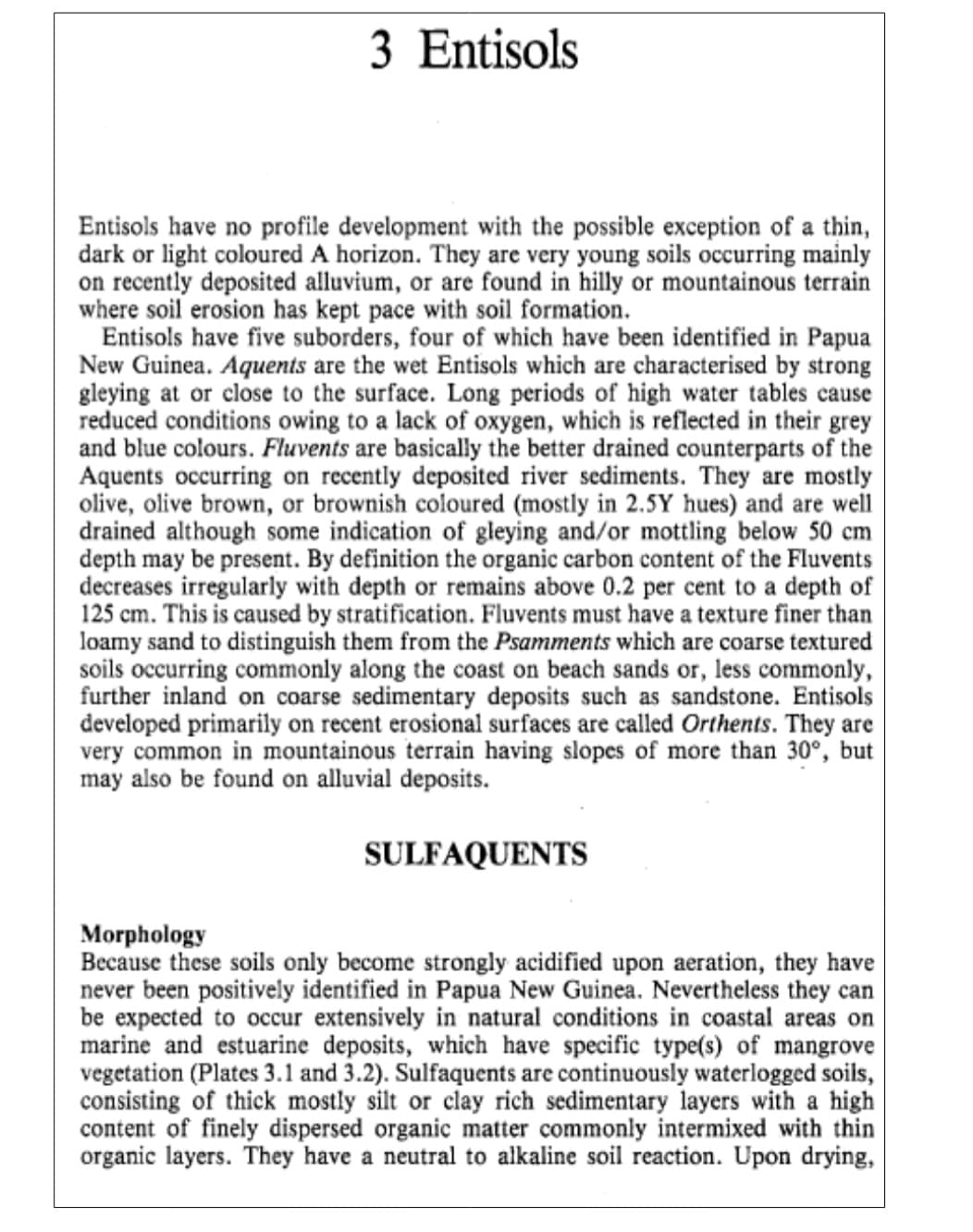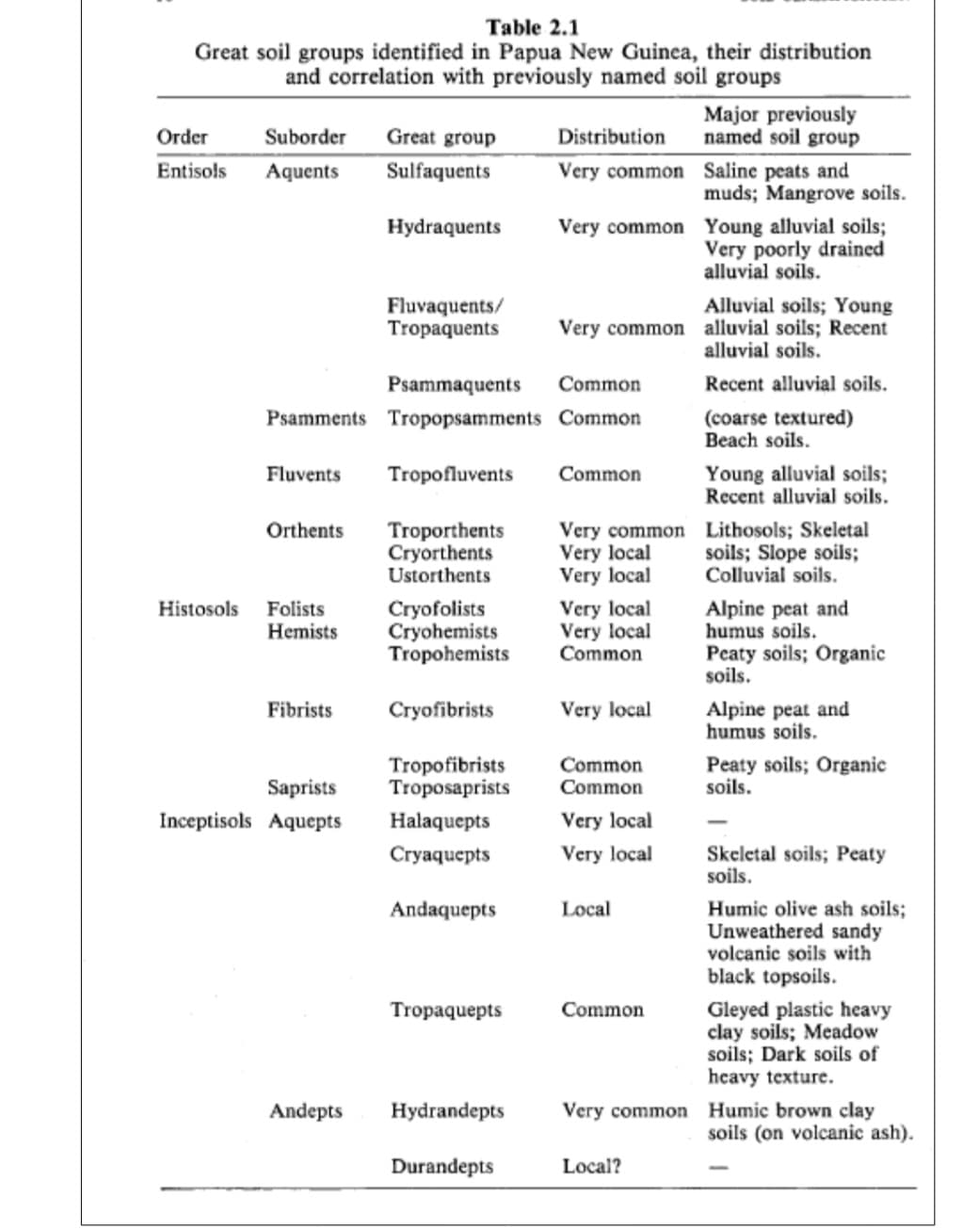Question 1.2 i). Give a brief description of the general environment in which each of the PNG’s Soil Order/Type is formed and found? ii). List the type of land use for each Soil Order/Type in PNG and briefly provide reason(s) for this?
Question 1.2 i). Give a brief description of the general environment in which each of the PNG’s Soil Order/Type is formed and found? ii). List the type of land use for each Soil Order/Type in PNG and briefly provide reason(s) for this?
Applications and Investigations in Earth Science (9th Edition)
9th Edition
ISBN:9780134746241
Author:Edward J. Tarbuck, Frederick K. Lutgens, Dennis G. Tasa
Publisher:Edward J. Tarbuck, Frederick K. Lutgens, Dennis G. Tasa
Chapter1: The Study Of Minerals
Section: Chapter Questions
Problem 1LR
Related questions
Question
Question 1.2
i). Give a brief description of the general environment in which each of the PNG’s Soil Order/Type is formed and found?
ii). List the type of land use for each Soil Order/Type in PNG and briefly provide reason(s) for this?
You will use the reference “Soils of Papua New Guinea by P. Bleeker, 1983” to answer part i) and ii).

Transcribed Image Text:3 Entisols
Entisols have no profile development with the possible exception of a thin,
dark or light coloured A horizon. They are very young soils occurring mainly
on recently deposited alluvium, or are found in hilly or mountainous terrain
where soil erosion has kept pace with soil formation.
Entisols have five suborders, four of which have been identified in Papua
New Guinea. Aquents are the wet Entisols which are characterised by strong
gleying at or close to the surface. Long periods of high water tables cause
reduced conditions owing to a lack of oxygen, which is reflected in their grey
and blue colours. Fluvents are basically the better drained counterparts of the
Aquents occurring on recently deposited river sediments. They are mostly
olive, olive brown, or brownish coloured (mostly in 2.5Y hues) and are well
drained although some indication of gleying and/or mottling below 50 cm
depth may be present. By definition the organic carbon content of the Fluvents
decreases irregularly with depth or remains above 0.2 per cent to a depth of
125 cm. This is caused by stratification. Fluvents must have a texture finer than
loamy sand to distinguish them from the Psamments which are coarse textured
soils occurring commonly along the coast on beach sands or, less commonly,
further inland on coarse sedimentary deposits such as sandstone. Entisols
developed primarily on recent erosional surfaces are called Orthents. They are
very common in mountainous terrain having slopes of more than 30°, but
may also be found on alluvial deposits.
SULFAQUENTS
Morphology
Because these soils only become strongly acidified upon aeration, they have
never been positively identified in Papua New Guinea. Nevertheless they can
be expected to occur extensively in natural conditions in coastal areas on
marine and estuarine deposits, which have specific type(s) of mangrove
vegetation (Plates 3.1 and 3.2). Sulfaquents are continuously waterlogged soils,
consisting of thick mostly silt or clay rich sedimentary layers with a high
content of finely dispersed organic matter commonly intermixed with thin
organic layers. They have a neutral to alkaline soil reaction. Upon drying,

Transcribed Image Text:Table 2.1
Great soil groups identified in Papua New Guinea, their distribution
and correlation with previously named soil groups
Order
Entisols
Suborder
Aquents
Orthents
Psammaquents Common
Psamments Tropopsamments Common
Histosols Folists
Hemists
Fluvents Tropofluvents Common
Fibrists
Great group
Sulfaquents
Hydraquents
Saprists
Inceptisols Aquepts
Andepts
Troporthents
Cryorthents
Ustorthents
Fluvaquents/
Alluvial soils; Young
Tropaquents Very common alluvial soils; Recent
alluvial soils.
Cryofolists
Cryohemists
Tropohemists
Distribution
Very common
Very common
Halaquepts
Cryaquepts
Andaquepts
Tropaquepts
Cryofibrists
Tropofibrists
Common
Troposaprists Common
Hydrandepts
Durandepts
Very common
Very local
Very local
Very local
Very local
Common
Very local
Very local
Very local
Local
Common
Major previously
named soil group
Saline peats and
muds; Mangrove soils.
Local?
Young alluvial soils;
Very poorly drained
alluvial soils.
Recent alluvial soils.
(coarse textured)
Beach soils.
Young alluvial soils;
Recent alluvial soils.
Lithosols; Skeletal
soils; Slope soils;
Colluvial soils.
Alpine peat and
humus soils.
Peaty soils; Organic
soils.
Alpine peat and
humus soils.
Peaty soils; Organic
soils.
Skeletal soils; Peaty
soils.
Humic olive ash soils;
Unweathered sandy
volcanic soils with
black topsoils.
Gleyed plastic heavy
clay soils; Meadow
soils; Dark soils of
heavy texture.
Very common Humic brown clay
soils (on volcanic ash).
Expert Solution
This question has been solved!
Explore an expertly crafted, step-by-step solution for a thorough understanding of key concepts.
Step by step
Solved in 2 steps

Recommended textbooks for you

Applications and Investigations in Earth Science …
Earth Science
ISBN:
9780134746241
Author:
Edward J. Tarbuck, Frederick K. Lutgens, Dennis G. Tasa
Publisher:
PEARSON

Exercises for Weather & Climate (9th Edition)
Earth Science
ISBN:
9780134041360
Author:
Greg Carbone
Publisher:
PEARSON

Environmental Science
Earth Science
ISBN:
9781260153125
Author:
William P Cunningham Prof., Mary Ann Cunningham Professor
Publisher:
McGraw-Hill Education

Applications and Investigations in Earth Science …
Earth Science
ISBN:
9780134746241
Author:
Edward J. Tarbuck, Frederick K. Lutgens, Dennis G. Tasa
Publisher:
PEARSON

Exercises for Weather & Climate (9th Edition)
Earth Science
ISBN:
9780134041360
Author:
Greg Carbone
Publisher:
PEARSON

Environmental Science
Earth Science
ISBN:
9781260153125
Author:
William P Cunningham Prof., Mary Ann Cunningham Professor
Publisher:
McGraw-Hill Education

Earth Science (15th Edition)
Earth Science
ISBN:
9780134543536
Author:
Edward J. Tarbuck, Frederick K. Lutgens, Dennis G. Tasa
Publisher:
PEARSON

Environmental Science (MindTap Course List)
Earth Science
ISBN:
9781337569613
Author:
G. Tyler Miller, Scott Spoolman
Publisher:
Cengage Learning

Physical Geology
Earth Science
ISBN:
9781259916823
Author:
Plummer, Charles C., CARLSON, Diane H., Hammersley, Lisa
Publisher:
Mcgraw-hill Education,